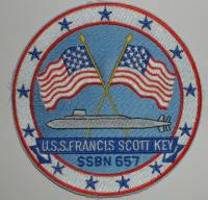
25 Sep 2023
25 Sep 2023 - 1546
25 Sep 2023
18 Oct 2021
Past Reunions
Reunion 2022
PHOTOS
By Location
By Decade
July 11, 2020
March 30, 2009
June 24, 2009
July 31, 2019
09 Feb 2022
Aug 27, 2018
May 27, 2009
Ship-Submarine recycling program
The Ship/Submarine
Recycling Program (SRP) is the process the United
States Navy uses to dispose of decommissioned nuclear vessels.
SRP takes place only at the Puget
Sound Naval Shipyard (PSNS) in Bremerton,
Washington, but the preparations can begin elsewhere. Before SRP can begin,
the ship or submarine must have her nuclear fuel removed.
Defueling usually coincides with decommissioning.
Prior to that event, the vessel referred to as "USS Name,"
but afterward the "USS" is dropped and it is referred to as "ex-Name."
Defueling of submarines is carried out at five ship repair facilities on the
West Coast, and the hulks are then towed to PSNS.
Reusable equipment is removed at the same time as the fuel. Spent nuclear fuel
is shipped by rail to the Naval
Reactor Facility in the Idaho National Engineering and Environmental
Laboratory (INEEL), located 67 kilometers (42 miles) northwest of Idaho
Falls, Idaho, where it is stored.
The fuel is not reprocessed. At PSNS the SRP proper begins.
A submarine
is cut into three or four pieces: the aft section, the reactor compartment, the
missile compartment if one exists, and the forward section.
Missile compartments are dismantled according to the provisions of the Strategic
Arms Reductions Treaty.
The ends of the reactor compartment are sealed and shipped by barge and
multiple-wheel high-capacity trailers to the Department
of Energy's Hanford Nuclear Reservation in Washington
state where they are buried.
The burial trenches have been evaluated to be secure for at least 600 years
before the first pinhole penetration of some lead containment areas of the
reactor compartment packages occurs, and several thousand years before leakage
becomes possible. Until 1991,
the forward and aft sections of the submarines were rejoined and placed in
floating storage.
Various proposals for disposal of those hulks were considered, including sinking
them at sea, but none were economically practical.
All required removal of the numerous polychlorinated
biphenyl products (PCBs) on board, which are considered hazardous materials
by the Environmental
Protection Agency and United
States Coast Guard.
In order to reduce the costs, the remaining submarine sections are recycled,
returning reusable materials to production.
In the process of submarine recycling, all hazardous and toxic wastes are
identified and removed, reusable equipment is removed and put into inventory.
Scrap metals and all other materials are sold to private companies or reused.
The overall process is not profitable, but does provide some cost relief.
Disposal of submarines by the SRP costs US$25-50 million per submarine. By the
end of 1994,
180 nuclear submarines had been built in the US.
Nearly 80 have been decommissioned, and 43 reactor compartments have been cut
and are stored at Hanford.
The Navy plans to decommission all remaining submarines of the Sturgeon
and Benjamin
Franklin classes in the first
decade of the 21st century, and has already begun to decommission some of
the Los
Angeles and Ohio
boats.